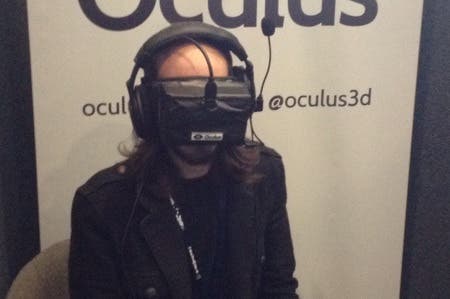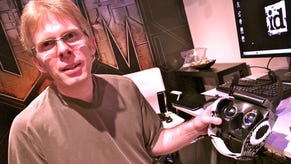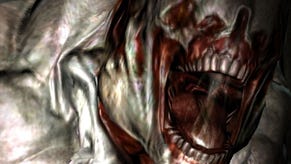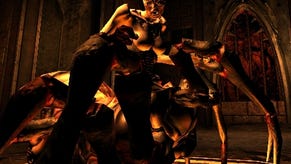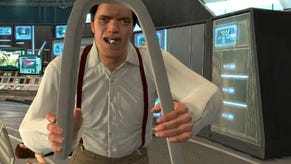Oculus Rift impressions: It's amazing until it makes you want to hurl
The VR goggles' central flaw and what's being done to fix it.
Prior to my appointment to see the Oculus Rift virtual reality headset on Sunday at PAX Prime I'd heard nothing but great things about it.
Oli Welsh called it "beyond thrilling" at E3, stating it "transforms the experience of playing a first-person video game." Our contributor Steve Haske said it was "mind-blowing," and my boy Hip Hop Gamer described it as "the f***ing Matrix."
Upon first donning the crude black taped goggles - this was a prototype model after all - I was equally astounded, with one not-so-minor side-effect; it left me horribly nauseous.
I only played Doom 3 on the Oculus for about five minutes, but for roughly a half-hour after I felt like I was going to hurl. When that cleared up, my pounding headache remained for a few hours more. It's worth noting that I'm not sensitive to motion-sickness at all. Games have never had the effect on me.
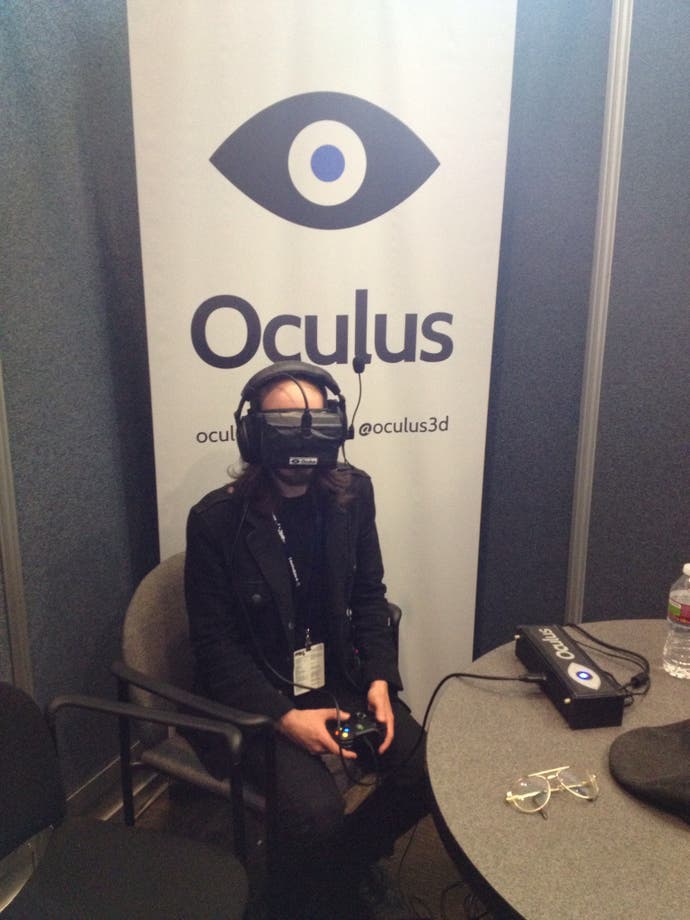
I was not alone in this. Half the people at my appointment felt equally ill following their hands-on and at least a couple other journalist friends I spoke to had the same experience.
When asked about this vice president of product Nate Mitchell said, "It depends largely on the person. I'd say two to three per cent of everyone we've demoed to gets motion sick."
Based on my admittedly small sample size it was closer to four out of ten.
"The first time I played I did feel a little dizzy. Second time better. Third time fine."
Nate Mitchell, vice president of product, Oculus
"It does take a second to get acclimated," said Mitchell, who explained that his first time with the Rift left him a little discombobulated. "The first time I played I did feel a little dizzy. Second time better. Third time fine."
He said that a lot of it is based on whether the person has tried VR before. "It doesn't have such an effect on them, because they're used to it. Palmer [Luckey, creator of the Rift] can spend eight to twelve hours in this thing and doesn't [get motion sick]."
Mitchell also explained that Oculus is working on improving the hardware and adding positional tracking, which will help alleviate this disconnect.
"The hardware can get better. And that can help a little bit in the sense that right now we don't have positional tracking." This would make it so moving your head side to side or up and down would be reflected in the game, as well as simply viewing angle as it's restricted to right now.
"In the consumer version one of the things we'd like to add - no promises - is positional tracking, so you can actually bend down and you'll bend down in the world... That would help with motion sickness because all motion sickness is is your visual cues not matching up to what your brain and body is expecting."
How good one's vision is can also affect one's experience with the Rift. My vision isn't terribly poor, but I am moderately nearsighted with astigmatism, so that could result in a more negative experience.
Mitchell noted that Oculus would like to make the Rift scale to one's prescription and add IPD (Interpupillary distance) adjustments that would make it suit people with eyes spaced apart at various distances.
"You can't just strap VR onto a game and have a good experience. You need to take the steps to make it great."
Nate Mitchell, vice president of product, Oculus

"There's also the IPD adjustments," he added. "If your brain is having trouble fusing this image for whatever reason it can give you a little headache, a little nausea. It all can get better."
Mitchell explained that it's also up to developers to design software that functions well for VR. He noted that Carmack removed the blowback-when-hit effect in Doom 3 to better suit the Rift.
"You can't just strap VR onto a game and have a good experience. You need to take the steps to make it great," he explained.
He hypothesised that if you had "the most perfect piece of hardware in the world and you strapped it to your head and played a video of you flying through space spinning in circles, you'd get motion sickness... At the end of the day it's up to developers to make content that's VR ready, that's designed for the Rift."
After only five minutes with the Rift it's impossible to tell if Mitchell is full of it or if this is the case, but it's worth noting that many experienced similar concerns with the 3DS, yet several people who complained about headaches based on their initial impressions with it later ended up regularly playing it with the 3D set to full blast. (It's also worth noting that I am not one of those people and prefer 2D 90 per cent of the time).
Outside of the queasiness and headache I felt, the technology itself is impressive. Aiming is almost telepathically easy as you aim by moving your head so you're naturally looking at the thing you want to shoot - something made easier by the aiming reticule being changed into a laser sight on the Rift. Unlike Oli, I did not experience any disconnect between using the gamepad and the Rift. The right analogue stick is still very useful for rounding corners or turning around, while anything in your immediate view is easy to focus on as it would be in real-life.
Ultimately, the Oculus Rift is a very impressive piece of technology, but one that comes with a major reservation in its prototype form. Still, I'm anxious to try it again and if this does indeed stop being an issue, the f***ing Matrix may be here sooner than we think.
